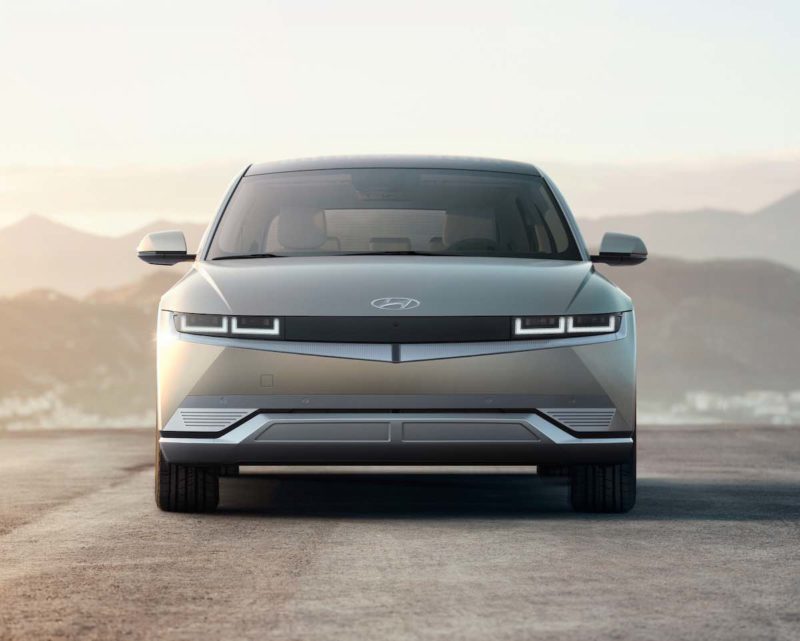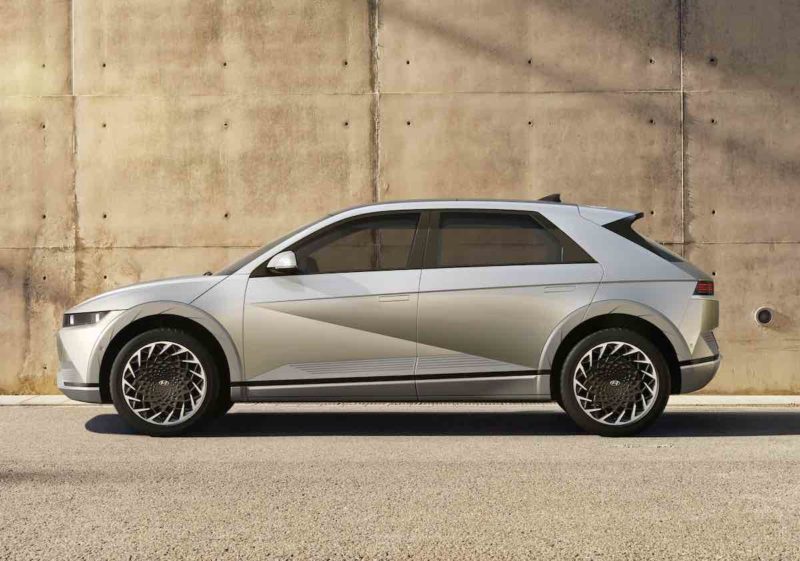South Korean car maker Hyundai has officially unveiled the Ioniq 5, a strapping SUV that marks the all-electric do-over of the formerly hybrid – and pretty underwhelming – Ioniq sub-brand, and the first in a new era of electric cars to be built using Hyundai’s dedicated new electric platform, the E-GMP.
The Ioniq 5 – which Hyundai Australia says will launch locally in Q3 of 2021 – was premiered in a virtual event on Tuesday evening (Australian eastern time) as the first model in Hyundai’s new-look Ioniq family and marking its “new benchmark” in electric mobility.
According to the literature, the Ioniq 5 will be available with a range of power electric configurations, including two battery pack options, either 58kWh or 72.6kWh, and two electric motor layouts, either with a rear motor only or with both front and rear motors – all with a top speed of 185 km/h.
At the top of the electric motor line-up is an all-wheel drive (AWD) option paired with the 72.6-kWh battery, which offers a combined power output of 225kWh and 605 Nm of torque – a configuration can take the SUV from 0-100 km/h in 5.2 seconds.
The two-wheel drive (2WD), 72.6 kWh battery configuration offers the Ioniq 5’s maximum driving range on a single charge, which Hyundai says will be around 470-480 km, according to the WLTP standard.

On charging, Hyundai says that using a 350kW charger, the Ioniq 5 can go from 10 per cent to 80 per cent in just 18 minutes – slightly longer than the rapid-charging time leaked in December – while just five minutes will offer 100km of range, according to WLTP.
As has been noted, Hyundai’s E-GMP, means the Ioniq 5 can support both 400V and 800V charging infrastructures – a “world first”patented technology that operates the motor and inverter to boost 400V to 800V for stable charging compatibility.
And as we note in more detail here, the Ioniq 5’s Vehicle-to-Load (V2L) function also allows customers to use or charge any electric devices, such as power tools, or camping equipment, effectively making it a “charger on wheels.”
See: Isn’t it Ioniq: New electric SUV can tow a tinny and charge your power tools
Hyundai says the V2L function can supply up to 3.6 kW of power, with one port located under the second-row seats and another located at the charging port on the vehicle exterior which provides power even when the car is turned off.
Notably, Hyundai says the Ioniq 5 can tow a trailer with a capacity up to 1,600kg, AND it can be equipped with a solar roof, which Hyundai says supports the vehicle’s electric power source by collecting energy from the sun and transferring it to the battery pack. Two big pluses for outdoor types like Australia’s prime minister ScoMo.

In its appearance, the SUV is a completely different beast from the Ioniq of the past; a redesign that is said to have been inspired by “the daring attitude of Hyundai Pony,” the company’s first production car – although we can’t see it ourselves.
Mostly, that comparison seems to refer to the Pony’s elongated wheel base, which in the case of the Ioniq 5 has translated to 3,000mm proportions. Otherwise, the Ioniq 5 design also features Hyundai’s first clamshell hood – to optimise aerodynamics – and a v-shaped bumper incorporating “distinctive” daytime running lights.
Other exterior design features include flush door handles, a “strong” and “distinctive” C-pillar shape, aero-optimised wheels, and a “vision roof” that consists of one large glass panel without any support materials.
On the most important matter – colour – Hyundai says customers can choose from nine exterior colours, “including five nature-inspired hues:” Gravity Gold Matte; Shooting-Star Gray Matte; Digital Teal-Green Pearl; Lucid Blue Pearl; Atlas White; Cyber Gray Metallic; Phantom Black Pearl; Galactic Gray Metallic Mystic Olive-Green Pearl.
Interior colours offer a choice of three: Obsidian Black; Dark Pebble Gray/Dove Gray; or Dark Teal/Dove Gray.
In the interior of the Ioniq 5, as was revealed not long ago by Hyundai, it is all about car as “living space,” with a moveable centre console, or “universal island,” that can slide back by 140mm over the the flat floor (0ver the battery pack) and create more space.
The electronically adjustable front seats can also recline to what Hyundai believes to be “the optimum angle” to create a weightless feeling for occupants. The thickness of the front seats has also been reduced by one-third to create more space in the back.

Trunk (or boot) space in the Ioniq 5 is listed at 531 litres, with the ability to increase to up to almost 1,600 litres when the second-row seats are fully folded, while a front trunk (or frunk) offers up to 57 litres of storage room.
“Ioniq 5 will accommodate lifestyles without limits, proactively caring for customers’ needs throughout their journey,” said Thomas Schemera, Hyundai’s executive vice president and global chief marketing officer in a statement on Tuesday.
“It is truly the first electric vehicle to provide a new experience with its innovative use of interior space and advanced technologies.”
On the advanced technologies front, Hyundai says the Ioniq 5 has a 12-inch, full-touch infotainment screen and hoodless 12- inch digital gauge cluster that can be customised to meet customers’ needs.
The SUV also features an Augmented Reality Head-Up Display (AR HUD) – the tech that uses the windshield as a display screen – and Hyundai SmartSense advanced driver assistance system, which the car maker says ensures the highest levels of safety and “convenience” on the road.
The Ioniq 5 will also be the first Hyundai model to offer Highway Driving Assist 2 (HDA 2), Forward Collision-Avoidance Assist (FCA), Blind-Spot Collision-Avoidance Assist (BCA), Intelligent Speed Limit Assist (ISLA), Driver Attention Warning (DAW), and High Beam Assist (HBA).
The SUV’s infotainment system integrates a new design theme called Jong-e Graphic User Interface (GUI) that offers a range of interior ambience settings, such as soft, delicate and exuberant. For those who feel the cold, there is are heated steering wheel and heated front seat functions.
“Hyundai’s new Ioniq brand represents the company’s strong commitment to sustainability and innovation,” said a statement accompanying the launch.
“The introduction of Ioniq 5 is the first step in the company’s journey of dedicated electric vehicles, moving another step closer towards achieving its clean mobility goals.
“Following the launch of Ioniq 5, Hyundai will expand its BEV lineup with Ioniq 6, an electric sedan, and Ioniq 7, a large electric SUV.”

Sophie is editor of One Step Off The Grid and deputy editor of its sister site, Renew Economy. Sophie has been writing about clean energy for more than a decade.

